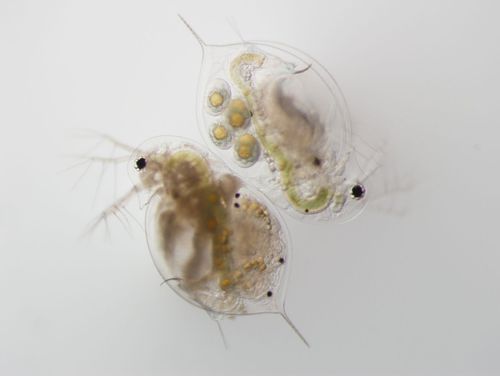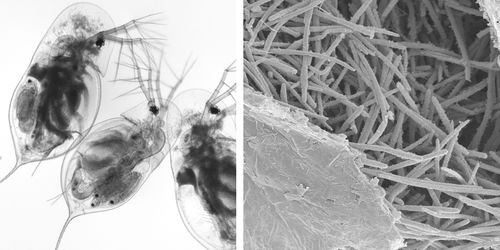Metschnikowia bicuspidata: Difference between revisions
mNo edit summary |
|||
| Line 2: | Line 2: | ||
==Introduction== | ==Introduction== | ||
[[File: | [[File:Metschnikowia_infected_daphnia_photo_by_duffy.jpeg|500px|thumb|right|An infected Daphnia dentifera (left) and an uninfected Daphnia dentifera (upper right). Embryos are clearly visible in the brood pouch on the uninfected animal's back. Photo by Meghan Duffy.]] | ||
''Metschnikowia'' is a genus in the Kingdom Fungi (Naumov, 2011). ''Metschnikowia'' are single-celled (i.e., yeast) parasites of freshwater zooplankton of the genus ''Daphnia'' (ibid.). | ''Metschnikowia'' is a genus in the Kingdom Fungi (Naumov, 2011). ''Metschnikowia'' are single-celled (i.e., yeast) parasites of freshwater zooplankton of the genus ''Daphnia'' (ibid.). | ||
Revision as of 22:55, 27 April 2015
Introduction
Metschnikowia is a genus in the Kingdom Fungi (Naumov, 2011). Metschnikowia are single-celled (i.e., yeast) parasites of freshwater zooplankton of the genus Daphnia (ibid.).
Description and Significance
The organism exists as single-celled needle-shaped spores (Naumov, 2011). M. bicuspidata lives in freshwater lakes in North America, Europe, ___ M. bicuspidata is a pathogen of Daphnia. M. bicuspidata uses energy from the host to produce tens of thousands of identical haploid spores. These increase in number until the Daphnia is killed and its carapace ruptures, introducing tens of thousands of new spores into the water column.
Classification
Eukaryota, Fungi, Dikarya, Ascomycota, Saccharomycotina, Saccharomycetes, Saccharomycetales, Metschnikowiaceae, Metschnikowia (European Nucleotide Archive, accessed 21 April 2015)
There are three varieties in the species: M. bicuspidata var. bicuspidata, var. californica, and var. chathamia (Naumov, 2011).
Genome Structure
size and content of the genome. number chromosomes, Circular or linear, Other interesting features. What is known about its sequence?
Cell Structure, Metabolism and Life Cycle
Interesting features of cell structure; how it gains energy; what important molecules it produces.
The sharp needle-shaped cells suggest a puncture mechanism of entering the Daphnia body. M. bicuspidata gets its energy by parasitising the freshwater zooplankton Daphnia.
The vegetative cells are spherical and haploid (Naumov, 2011). Haploid vegetative cells may fuse to form a dikaryotic cell (one cell with two distinct nuclei) (Naumov, 2011). This cell may then undergo karyogamy to become a single diploid cell (ibid.). The diploid cell may then undergo meiotic haploidization to yield asci containing ascospores, each of which may be one of a variety of mating types (Naumov, 2011). Alternatively, the diploid cell may undergo mitotic haploidization and yield several haploid vegetative cells (ibid.).
The haploid ascospores are the virulent form of M. bicuspidata (Naumov, 2011).
Ecology and Pathogenesis
Exposure of host Daphnia to parasitic M. bicuspidata occurs during feeding. Daphnia eat algae in the water column and feed indiscriminately on whatever floating particles fit into their mouths. During feeding, M. bicuspidata spores enter the Daphnia mouth, travel along the gut, and puncture the gut wall. Infection occurs when a spore punctures the wall, enters the hemolymph, and begin reproducing (Ebert et al., 2000).
M. bicuspidata kills the host D. magna in 7-25 days (average = 17.5 days); a healthy D. magna typically lives 40-80 days (Ebert et al., 2000).
Susceptibility to infection varies across host genotypes ( ). Infected D. magna exhibit reduced fecundity (Ebert et al., 2000). Upon death due to infection, Daphnia may yield 10,000 to 70,000 spores per individual (Penczykowski et al., 2014).
M. bicuspidata uses energy from the Daphnia body to reproduce (Hall et al., 2009).
Transmission is horizontal, meaning infection occurs within a host generation and is not transmitted from parent to offspring (Ebert et al., 2000).
References
http://www.ebi.ac.uk/ena/data/view/Taxon:Metschnikowia%20bicuspidata%20var.%20bicuspidata%20NRRL%20YB-4993 European Nucleotide Archive. Metschnikowia bicuspidata var. bicuspidata NRRL YB-4993. accessed 21 April 2015.
Ebert, D., Lipsitch, M., Mangin, K. L. "The Effect of Parasites on Host Population Density and Extinction: Experimental Epidemiology with Daphnia and Six Microparasites." The American Naturalist. 2000. Volume 156(5). pp. 459-477.
Hall, S. R., Simonis, J. L., Nisbet, R. M., Tessier, A. J., Cáceres, C. E. "Resource Ecology of Virulence in a Planktonic Host‐Parasite System: An Explanation Using Dynamic Energy Budgets." The American Naturalist. 2009. Volume 174(2). pp. 149-162.
Naumov, G. I. "Molecular and genetic differentiation of small-spored species of the yeast genus Metschnikowia Kamienski." Microbiology. 2011. Volume 80(2). pp. 135-142.
Penczykowski, R. M., Lemanski, B. C. P., Sieg, R. D., Hall, S. R., Ochs, J. H., Kubanek, J., Duffy, M. A. "Poor resource quality lowers transmission potential by changing foraging behavior." Functional Ecology. 2014. Volume 28. pp. 1245-1255.
Author
Page authored by Katie Griebel and Jacob Gelarden, students of Prof. Jay Lennon at Indiana University.


